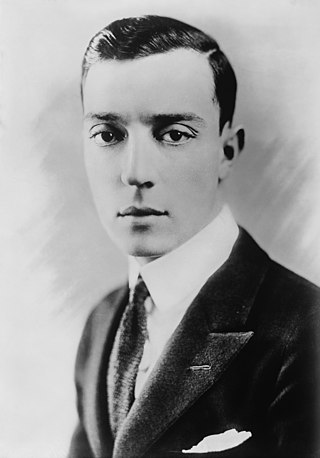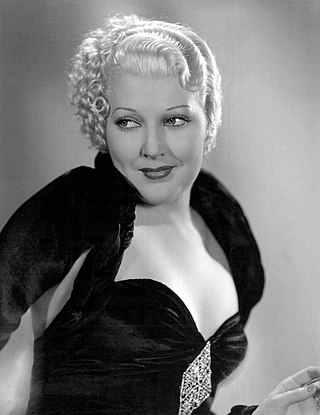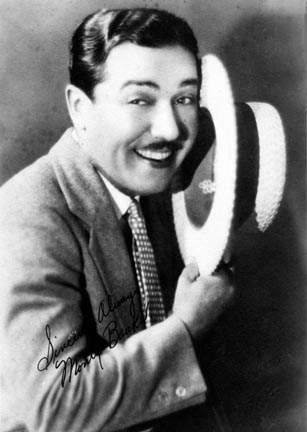
Joseph Frank "Buster" Keaton was an American actor, comedian and film director. He is best known for his silent films during the 1920s, in which he performed physical comedy and inventive stunts. He frequently maintained a stoic, deadpan facial expression that became his trademark and earned him the nickname "The Great Stone Face".

The Hollywood Revue of 1929, or simply The Hollywood Revue, is a 1929 American pre-Code musical comedy film released by Metro-Goldwyn-Mayer. It was the studio's second feature-length musical, and one of their earliest sound films. Produced by Harry Rapf and Irving Thalberg and directed by Charles Reisner, it features nearly all of MGM's stars in a two-hour revue that includes three segments in Technicolor. The masters of ceremonies are Conrad Nagel and Jack Benny.

Laurel and Hardy were a British-American comedy team during the early Classical Hollywood era of American cinema, consisting of Englishman Stan Laurel (1890–1965) and American Oliver Hardy (1892–1957). Starting their career as a duo in the silent film era, they later successfully transitioned to "talkies". From the late 1920s to the mid-1950s, they were internationally famous for their slapstick comedy, with Laurel playing the clumsy, childlike friend to Hardy's pompous bully. Their signature theme song, known as "The Cuckoo Song", "Ku-Ku", or "The Dance of the Cuckoos" was heard over their films' opening credits, and became as emblematic of them as their bowler hats.

Charles Joseph Parrott, known professionally as Charley Chase, was an American comedian, actor, screenwriter and film director. He worked for many pioneering comedy studios but is chiefly associated with producer Hal Roach. Chase was the elder brother of comedian/director James Parrott.

Thelma Alice Todd was an American actress and businesswoman who carried the nicknames "The Ice Cream Blonde" and "Hot Toddy". Appearing in about 120 feature films and shorts between 1926 and 1935, she is remembered for her comedic roles opposite ZaSu Pitts, and in films such as Marx Brothers' Monkey Business and Horse Feathers and a number of Charley Chase's short comedies. She co-starred with Buster Keaton and Jimmy Durante in Speak Easily. She also had roles in several Wheeler and Woolsey and Laurel and Hardy films, the last of which featured her in a part that was cut short by her sudden death in 1935 at the age of 29.

Silent comedy is a style of film, related to but distinct from mime, invented to bring comedy into the medium of film in the silent film era (1900s–1920s) before a synchronized soundtrack which could include talking was technologically available for the majority of films. Silent comedy is still practiced, albeit much less frequently, and it has influenced comedy in modern media as well.
The following is a complete list of the 220 Our Gang short films produced by Hal Roach Studios and/or Metro-Goldwyn-Mayer between 1922 and 1944, numbered by order of release along with production order.

James Henderson Finlayson was a Scottish actor who worked in both silent and sound comedies. Balding, with a fake moustache, he had many trademark comic mannerisms—including his squinting, outraged double-take reactions, and his characteristic exclamation: "D'ooooooh!" He is the best remembered comic foil of Laurel and Hardy.

James Wesley Horne was an American actor, screenwriter, and film director.

Educational Pictures, also known as Educational Film Exchanges, Inc. or Educational Films Corporation of America, was an American film production and film distribution company founded in 1916 by Earle Hammons (1882–1962). Educational primarily distributed short subjects; it is best known for its series of comedies starring Buster Keaton (1934–37) and the earliest screen appearances of Shirley Temple (1932–34). The company ceased production in 1938, and finally closed in 1940 when its film library was sold at auction.

Montague (Monty) Banks was a 20th century Italian-born American comedian, film actor, director and producer who achieved success in the United States and United Kingdom.

You're Darn Tootin' is a silent short subject directed by E. Livingston Kennedy starring comedy duo Laurel and Hardy. It was released on April 21, 1928, by Metro-Goldwyn-Mayer.

Call of the Cuckoo (1927) is a Hal Roach two reel silent film released by Metro-Goldwyn-Mayer. The film's principal star is comedian Max Davidson, though the film is just as well known for cameos from other Roach stars at the time. These cameos include renowned supporting player Jimmy Finlayson, the oft underrated/ignored Charley Chase, and a pre-teaming Stan Laurel and Oliver Hardy.

The Battle of the Century is a 1927 silent short film starring comedy double act Laurel and Hardy, who appeared in 107 films between 1921 and 1951. The film entered the public domain in the United States in 2023.
Robert Youngson was a film producer, director, and screenwriter, specializing in reviving antique silent films.

Edward Sedgwick was an American film director, writer, actor and producer.

Now I'll Tell One is a 1927 silent film starring Charley Chase. The film features Stan Laurel and Oliver Hardy, prior to their official billing as the duo Laurel and Hardy. Both comedians had bit parts and share no scenes together.

The Golden Age of Comedy (1957) is a compilation of silent comedy films from the Mack Sennett and Hal Roach studios, written and produced by Robert Youngson.
Edward Frank Dunn was an American actor best known for his roles in comedy films, supporting many comedians such as Charley Chase, Charlie Chaplin, W. C. Fields and Laurel and Hardy.

Kewpie Morgan was an American silent film comedian who also performed in a few early sound films. He appeared in 99 films from 1915 to 1936. He appeared in the films of such comedians as Buster Keaton and Laurel and Hardy. He posthumously appeared in Robert Youngson compilations of the 1960s highlighting silent film comedy.

















